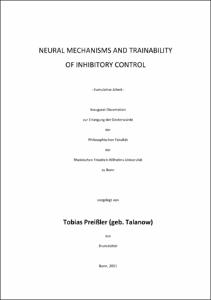Preißler, Tobias: Neural mechanisms and trainability of inhibitory control. - Bonn, 2021. - Dissertation, Rheinische Friedrich-Wilhelms-Universität Bonn.
Online-Ausgabe in bonndoc: https://nbn-resolving.org/urn:nbn:de:hbz:5-60615
Online-Ausgabe in bonndoc: https://nbn-resolving.org/urn:nbn:de:hbz:5-60615
@phdthesis{handle:20.500.11811/8880,
urn: https://nbn-resolving.org/urn:nbn:de:hbz:5-60615,
author = {{Tobias Preißler}},
title = {Neural mechanisms and trainability of inhibitory control},
school = {Rheinische Friedrich-Wilhelms-Universität Bonn},
year = 2021,
month = jan,
note = {Response inhibition is a facet of mental functions, termed executive functions, by which humans control their behavior in consideration of environmental conditions. Response inhibition allows to control automatic and impulsive reactions in favor of more appropriate, voluntary and goal-directed responses. It is a behavioral mechanism that is crucially involved in accomplishing many everyday tasks. Its deficits play an important role in psychopathology. The model system of saccadic eye movements is a well-established framework to study response inhibition in psychology and cognitive neuroscience. However, the precise nature of the response inhibition mechanism and the potential of inhibition abilities to be subject to training and transfer remain not fully understood to date despite intensive research. Thus, this dissertation comprises three peer-reviewed research projects that aimed to contribute to a better understanding of the response inhibition component and how it shapes our behavior.
An initial study reported evidence in favor of the competitive integrative nature of opposing response decision signals in the antisaccade task. The results matched a metaphorical account of a horse-race towards a response threshold. It implies that response inhibition does not require a distinct stop or inhibition signal, but an accumulation mechanism.
A second study investigated brain activations during the planning (proactive) and response (reactive) phase in two saccadic response inhibition tasks by altering the certainty of the task-set. Task-set certainty likely biased task-set and stimulus encoding as well as processes underlying response selection, that resulted in more successful inhibition. Foreknowledge of the task-set distinctly altered proactive and reactive brain signals. The results indicated an important role of a brain region in supramarginal gyrus/inferior parietal lobe in planning and facilitation of saccadic response inhibition.
A third study assessed training and transfer effects of response inhibition abilities in the light of Miyake and Friedman’s Unity and Diversity Model of executive functions. A transfer of inhibition gains to updating, shifting and response planning abilities was expected according to the model. Response inhibition abilities were indeed subject to training. However, training gains were limited to the trained inhibition task and did not transfer to other untrained facets of executive functions. Further research in samples that deviate from an optimal level of inhibition abilities might be a promising next step to exhibit long-term training and transfer effects in inhibition.
Overall, this dissertation highlights fundamental principles of planning and facilitation underlying reflex control and decision making. It challenges the assumption of performance transfer in cognitive training.},
url = {https://hdl.handle.net/20.500.11811/8880}
}
urn: https://nbn-resolving.org/urn:nbn:de:hbz:5-60615,
author = {{Tobias Preißler}},
title = {Neural mechanisms and trainability of inhibitory control},
school = {Rheinische Friedrich-Wilhelms-Universität Bonn},
year = 2021,
month = jan,
note = {Response inhibition is a facet of mental functions, termed executive functions, by which humans control their behavior in consideration of environmental conditions. Response inhibition allows to control automatic and impulsive reactions in favor of more appropriate, voluntary and goal-directed responses. It is a behavioral mechanism that is crucially involved in accomplishing many everyday tasks. Its deficits play an important role in psychopathology. The model system of saccadic eye movements is a well-established framework to study response inhibition in psychology and cognitive neuroscience. However, the precise nature of the response inhibition mechanism and the potential of inhibition abilities to be subject to training and transfer remain not fully understood to date despite intensive research. Thus, this dissertation comprises three peer-reviewed research projects that aimed to contribute to a better understanding of the response inhibition component and how it shapes our behavior.
An initial study reported evidence in favor of the competitive integrative nature of opposing response decision signals in the antisaccade task. The results matched a metaphorical account of a horse-race towards a response threshold. It implies that response inhibition does not require a distinct stop or inhibition signal, but an accumulation mechanism.
A second study investigated brain activations during the planning (proactive) and response (reactive) phase in two saccadic response inhibition tasks by altering the certainty of the task-set. Task-set certainty likely biased task-set and stimulus encoding as well as processes underlying response selection, that resulted in more successful inhibition. Foreknowledge of the task-set distinctly altered proactive and reactive brain signals. The results indicated an important role of a brain region in supramarginal gyrus/inferior parietal lobe in planning and facilitation of saccadic response inhibition.
A third study assessed training and transfer effects of response inhibition abilities in the light of Miyake and Friedman’s Unity and Diversity Model of executive functions. A transfer of inhibition gains to updating, shifting and response planning abilities was expected according to the model. Response inhibition abilities were indeed subject to training. However, training gains were limited to the trained inhibition task and did not transfer to other untrained facets of executive functions. Further research in samples that deviate from an optimal level of inhibition abilities might be a promising next step to exhibit long-term training and transfer effects in inhibition.
Overall, this dissertation highlights fundamental principles of planning and facilitation underlying reflex control and decision making. It challenges the assumption of performance transfer in cognitive training.},
url = {https://hdl.handle.net/20.500.11811/8880}
}






